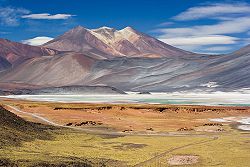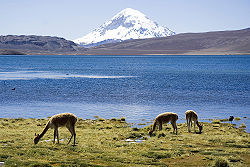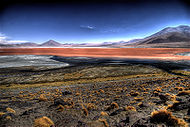
Central Andean dry puna
Encyclopedia
The Central Andean dry puna is an ecoregion
, in the Montane grasslands and shrublands
biome
, located in the Andean High plateau, in South America
. It is a part of the Puna grassland
.
and is located east of the Atacama Desert
.
Salt Flats, locally known as Salares, are a characteristic feature of this ecoregion. Among the largest salares are Coipasa, Uyuni
, Atacama
, and Arizaro. Other major geographical features are the lakes Poopó and Coipasa, and the many volcanoes that tower over the altiplano, including Parinacota Volcano, Nevado Sajama
, Tata Sabaya
, Ollagüe
, Licancabur
, Lascar, Aracar
, Socompa
and Llullaillaco
. In addition to, numerous and colorful small lakes and ponds dot this region. There are seasonal as well as permanent, and have different degrees of salinity
.
 Typical high Andean wetland
Typical high Andean wetland
s are the Bofedales. These marshy areas are characterized by the presence of cushion bog vegetation. The Yareta
grows in well-drained soils. Grasslands are dominated by species of the genera Stipa
and Festuca.
Central Andean dry puna is home to Polylepis
species, including the Polylepis tarapacana
, which is the woody plant that grows at the highest elevations in the world.
 Camelid
Camelid
s, such as llama
s, alpaca
s, vicuña
s, are found in this ecoregion. Other mammals include the Cougar, Andean Mountain Cat, Andean Fox, and the Andean Hairy Armadillo
.
Three of the six flamingo
species inhabit here. They are Andean Flamingo
, James's Flamingo
, and Chilean Flamingo
. Other remarkable birds are the Darwin's Rhea
, Andean Condor
, Puna Tinamou
, Puna Teal
, Puna Ibis
and the Andean Goose
.
 Animals and plants find refuge in the protected areas of this ecoregion. Those include:
Animals and plants find refuge in the protected areas of this ecoregion. Those include:
Ecoregion
An ecoregion , sometimes called a bioregion, is an ecologically and geographically defined area that is smaller than an ecozone and larger than an ecosystem. Ecoregions cover relatively large areas of land or water, and contain characteristic, geographically distinct assemblages of natural...
, in the Montane grasslands and shrublands
Montane grasslands and shrublands
Montane grasslands and shrublands is a biome defined by the World Wildlife Fund. The biome includes high altitude grasslands and shrublands around the world....
biome
Biome
Biomes are climatically and geographically defined as similar climatic conditions on the Earth, such as communities of plants, animals, and soil organisms, and are often referred to as ecosystems. Some parts of the earth have more or less the same kind of abiotic and biotic factors spread over a...
, located in the Andean High plateau, in South America
South America
South America is a continent situated in the Western Hemisphere, mostly in the Southern Hemisphere, with a relatively small portion in the Northern Hemisphere. The continent is also considered a subcontinent of the Americas. It is bordered on the west by the Pacific Ocean and on the north and east...
. It is a part of the Puna grassland
Puna grassland
The Puna grassland ecoregion, of the montane grasslands and shrublands biome, is found in the central Andes Mountains of South America. It is considered one of the eight Natural Regions in Peru, but extends south as far as northern Argentina and Chile....
.
Setting
This ecoregion occupies the southwestern portion of the AltiplanoAltiplano
The Altiplano , in west-central South America, where the Andes are at their widest, is the most extensive area of high plateau on Earth outside of Tibet...
and is located east of the Atacama Desert
Atacama Desert
The Atacama Desert is a plateau in South America, covering a strip of land on the Pacific coast, west of the Andes mountains. It is, according to NASA, National Geographic and many other publications, the driest desert in the world...
.
Salt Flats, locally known as Salares, are a characteristic feature of this ecoregion. Among the largest salares are Coipasa, Uyuni
Salar de Uyuni
Salar de Uyuni is the world's largest salt flat at . It is located in the Potosí and Oruro departments in southwest Bolivia, near the crest of the Andes, and is elevated above the mean sea level. The Salar was formed as a result of transformations between several prehistoric lakes...
, Atacama
Salar de Atacama
Salar de Atacama is the largest salt flat in Chile. It is located south of San Pedro de Atacama, is surrounded by mountains and has no drainage outlets. To the east is enclosed by the main chain of the Andes, while to the west lies a secondary mountain range of the Andes called Cordillera de Domeyko...
, and Arizaro. Other major geographical features are the lakes Poopó and Coipasa, and the many volcanoes that tower over the altiplano, including Parinacota Volcano, Nevado Sajama
Nevado Sajama
Nevado Sajama is an extinct stratovolcano and the highest peak in Bolivia. The mountain is located in the Oruro Department, Sajama Province, Curahuara de Carangas Municipality, Sajama Canton. It is situated in the Sajama National Park in the southwest area of the country some 16–24 km from...
, Tata Sabaya
Tata Sabaya
Tata Sabaya is a stratovolcano in Bolivia. It is located at the northern end of the Salar de Coipasa, which lies in the Altiplano. It also lies at eastern end of a line of volcanoes starting with Isluga in the west, and continuing with Cabaray. Its last eruption date is unknown, but it is assigned...
, Ollagüe
Ollagüe
Ollagüe is a massive andesite stratovolcano in the Andes on the border between Bolivia and Chile. It is located southeast of the village that shares its name....
, Licancabur
Licancabur
Licancabur is a highly symmetrical stratovolcano on the southernmost part of the border between Chile and Bolivia. It is located just southwest of Laguna Verde in Bolivia. The volcano dominates the landscape of the Salar de Atacama area...
, Lascar, Aracar
Aracar
Aracar is a large conical stratovolcano in northwestern Argentina, just east of the Chilean border. It has an uneroded summit crater about in diameter which contains a small crater lake. It is located on the edge of the Puna de Atacama, a high desert plateau east of the Atacama Desert...
, Socompa
Socompa
Socompa is a large complex stratovolcano at the border of Argentina and Chile. It is best known for its large debris avalanche deposit, which is widely accepted as the best-preserved example of this type of deposit in the world, and also notable as the home of the world's most elevated known...
and Llullaillaco
Llullaillaco
Llullaillaco is a stratovolcano at the border of Argentina and Chile. It lies in the Puna de Atacama, a region of very high volcanic peaks on a high plateau within the Atacama Desert, one of the driest places in the world...
. In addition to, numerous and colorful small lakes and ponds dot this region. There are seasonal as well as permanent, and have different degrees of salinity
Salinity
Salinity is the saltiness or dissolved salt content of a body of water. It is a general term used to describe the levels of different salts such as sodium chloride, magnesium and calcium sulfates, and bicarbonates...
.
Flora

Wetland
A wetland is an area of land whose soil is saturated with water either permanently or seasonally. Wetlands are categorised by their characteristic vegetation, which is adapted to these unique soil conditions....
s are the Bofedales. These marshy areas are characterized by the presence of cushion bog vegetation. The Yareta
Yareta
Yareta is a tiny flowering plant in the family Apiaceae native to South America, occurring in the Puna grasslands of the Andes in Peru, Bolivia, the north of Chile and the west of Argentina at between 3200 and 4500 metres altitude.Yareta is an evergreen perennial being in leaf...
grows in well-drained soils. Grasslands are dominated by species of the genera Stipa
Stipa
This article is about a type of grass.For Speech Transmission Index for Public Address Systems, see Speech transmission index.For the Italian aircraft designer, see Luigi Stipa...
and Festuca.
Central Andean dry puna is home to Polylepis
Polylepis
Polylepis is a genus containing about twenty species of shrubs or trees native to the mid- and high-elevation regions of the tropical Andes. This group is unique in the rose family in that it is predominantly wind-pollinated. They are usually gnarled in shape, but in certain areas some trees are...
species, including the Polylepis tarapacana
Polylepis tarapacana
Polylepis tarapacana, known in its native habitat by the Spanish common name Queñoa De Altura , is a short tree or shrub which is found in small, scattered groupings along the mountainous borders of Bolivia, Chile, and Peru , growing in soil formed by volcanos...
, which is the woody plant that grows at the highest elevations in the world.
Fauna

Camelid
Camelids are members of the biological family Camelidae, the only living family in the suborder Tylopoda. Dromedaries, Bactrian Camels, llamas, alpacas, vicuñas, and guanacos are in this group....
s, such as llama
Llama
The llama is a South American camelid, widely used as a meat and pack animal by Andean cultures since pre-Hispanic times....
s, alpaca
Alpaca
An alpaca is a domesticated species of South American camelid. It resembles a small llama in appearance.Alpacas are kept in herds that graze on the level heights of the Andes of southern Peru, northern Bolivia, Ecuador, and northern Chile at an altitude of to above sea level, throughout the year...
s, vicuña
Vicuña
The vicuña or vicugna is one of two wild South American camelids, along with the guanaco, which live in the high alpine areas of the Andes. It is a relative of the llama, and is now believed to share a wild ancestor with domesticated alpacas, which are raised for their fibre...
s, are found in this ecoregion. Other mammals include the Cougar, Andean Mountain Cat, Andean Fox, and the Andean Hairy Armadillo
Andean Hairy Armadillo
The Andean Hairy Armadillo is an armadillo present in Bolivia, in the region of the Puna, the departments of Oruro, La Paz, and Cochabamba . Nowark describes it as distributed in Bolivia and northern Chile. A recent publication of Pacheco et al. also locates the species in Peru...
.
Three of the six flamingo
Flamingo
Flamingos or flamingoes are gregarious wading birds in the genus Phoenicopterus , the only genus in the family Phoenicopteridae...
species inhabit here. They are Andean Flamingo
Andean Flamingo
The Andean flamingo, or Phoenicopterus andinus, is one of the rarest flamingos in the world. It has a pale pink body with brighter upperparts, deep vinaceous-pink lower neck, breast, and wing-coverts. It is the only flamingo species with yellow legs and three-toed feet. The bill of the Andean...
, James's Flamingo
James's Flamingo
James's Flamingo is also known as the Puna Flamingo. Named for Harry Berkeley James, it populates the high altitudes of Andean plateaus of Peru, Chile, Bolivia and Argentina. It is closely related to the Andean Flamingo, and the two make up the genus Phoenicoparrus...
, and Chilean Flamingo
Chilean Flamingo
The Chilean Flamingo is a large species closely related to Caribbean Flamingo and Greater Flamingo, with which it was sometimes considered conspecific...
. Other remarkable birds are the Darwin's Rhea
Darwin's Rhea
Darwin's Rhea, Rhea pennata, also known as the Lesser Rhea, is a large flightless bird, but the smaller of the two extant species of rheas. It is found in the Altiplano and Patagonia in South America.-Description:...
, Andean Condor
Andean Condor
The Andean Condor is a species of South American bird in the New World vulture family Cathartidae and is the only member of the genus Vultur...
, Puna Tinamou
Puna Tinamou
The Puna Tinamou, Tinamotis pentlandii also known as Pentland’s Tinamou is a member of the most ancient groups of bird families, the tinamous. This species is native to southern South America.-Taxonomy:...
, Puna Teal
Puna Teal
The Puna Teal is a species of dabbling duck in the genus Anas. It was previously regarded as a subspecies of the Silver Teal....
, Puna Ibis
Puna Ibis
The Puna Ibis is a species of bird in the Threskiornithidae family. It is found in Argentina, Bolivia, Chile, and Peru. Its natural habitat is swamps.-References:* BirdLife International 2004. . Downloaded on 24 July 2007....
and the Andean Goose
Andean Goose
The Andean Goose, Chloephaga melanoptera, is a member of the duck, goose and swan family Anatidae. It is in the shelduck subfamily Tadorninae.It is resident around lakes and marshes in the high Andes, usually well above 3000 m...
.
Population and conservation

- Lauca National ParkLauca National ParkLauca National Park is located in Chile's far north, in the Andean range. It encompasses an area of 1,379 km² of altiplano and mountains, the latter consisting mainly of enormous volcanoes. Las Vicuñas National Reserve is its neighbour to the south. Both protected areas, along with Salar de Surire...
- Sajama National ParkSajama National ParkSajama National Park is a national park located in the Oruro Department, Bolivia. It borders Lauca National Park in Chile.The park lies within the Central Andean dry puna ecoregion.. It features a spectacular Andean landscape, with elevations ranging from . It contains the snowy cone of Nevado...
- Eduardo Avaroa Andean Fauna National ReserveEduardo Avaroa Andean Fauna National ReserveThe Eduardo Avaroa Andean Fauna National Reserve is located in Sur Lípez Province. Situated in the far southwestern region of Bolivia, it is the country's most visited protected area...
- Los Flamencos National ReserveLos Flamencos National ReserveLos Flamencos National Reserve is a nature reserve located in the commune of San Pedro de Atacama, Antofagasta Region of Chile. The reserve covers a total area of in the Central Andean dry puna ecoregion and consists of seven separate sectors....
- Olaroz-Cauchari Flora and Fauna Reserve
- Llullaillaco National ParkLlullaillaco National ParkLlullaillaco National Park is a national park of Chile, located 275 km southeast of Antofagasta in the Andes. It lies between the eastern slopes of the Cordillera Domeyko and the international border with Argentina. In the park there are several important mountains that culminate at the summit...

